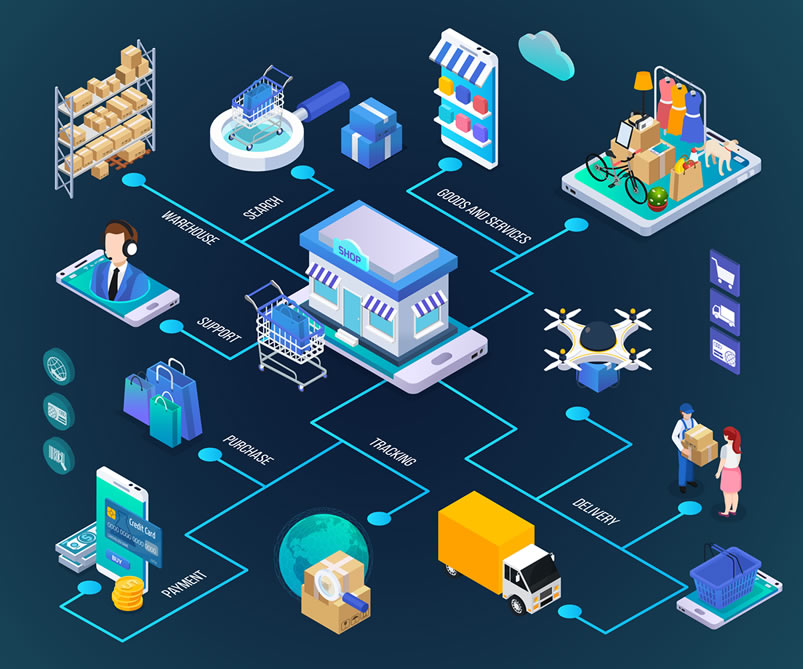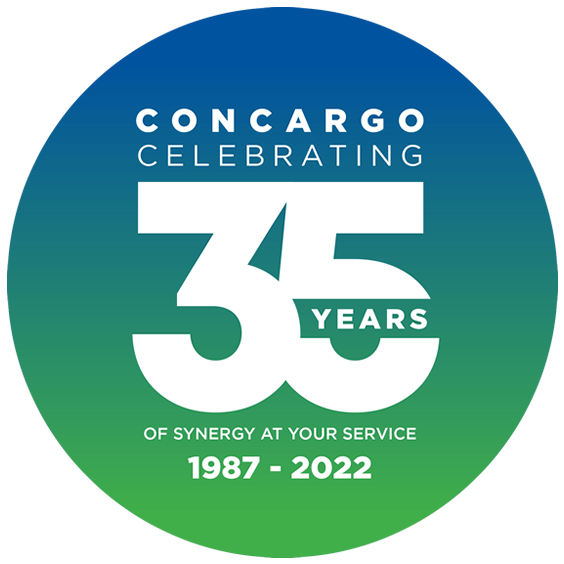ECOMMERCE
Concargo, your local street smart, agile, and resilient on-demand warehouse destination in SA. Your Pop-Up warehouse partner...
Concargo has evolved into a Smart Warehouse Destination of the future that takes advantage of automated capacity management by leveraging technology for better, data-driven capacity planning replacing the traditional legacy of past supply chains. On-demand warehousing is our core focus: packing, stacking, and delivering cost effective and sustainable solutions to optimise performance with technology in a shared economy. Smart supply and predictive maintenance ensure we avoid equipment issues and protect perishable stock.
Concargo has ensured we improve Pick and stow Routes in KZN and ensure we audit and customise your workflows meeting the increasing demands of consumers wanting shorter delivery times and accountable logistics. Concargo prides us in seizing today’s tremendous opportunities to design flexible warehouses that are part of a resilient, energy-efficient, safe, and optimized enterprise ecosystem—that is, a fully sustainable warehouse, prepared and ready for a productive and thriving future.
E-commerce is growing – Concargo is Growing with It!
Providing efficiency and end-to-end visibility to the e-commerce supply chain.
The sharing economy
The simple concept of the sharing economy is now being applied to warehousing too thanks to the evolution of the technology that first enabled apps like Uber. For example, it is now possible for spare capacity on premises to be leased out and for those who need space to rent it on demand in a much more flexible way. This approach is more agile and could be responsible for significant change in the warehousing sector, for example warehouse owners now have a commercial asset in unused space, something that can be valued and sold. As a result, the cost of significant unused space no longer needs to be a burden.
Proactive maintenance
Maintenance has traditionally been reactive, focusing on fixing issues after they have already arisen, often causing delays and downtime as a result. Today, tech such as AI, smart supply chains and sensors is changing this, shifting maintenance to a predictive position so that it can be used to avoid equipment issues and protect perishable stock. Not only that but predictive maintenance also has a big role to play in optimising performance too.
Concargo’s 8 easy ways to cut costs and increase warehouse efficiency
- Optimize Warehouse Storage.
- Give Customers More Pickup & Delivery Options.
- Improve Pick and Stow Routes in Your Warehouse.
- Upgrade Mobile Technology in Your Warehouse.
- Create an Inventory Review Process.
- Review Product Replenishment Practices.
- Audit Packaging for Products and Shipment.
- Standardize and Audit Your Workflows.
Warehousing is a part of the supply chain that is currently evolving at an impressive pace. legacy business models are being overhauled to accommodate the increasing demands of consumers who want short delivery times, accountable logistics and cheaper and more efficient options.
Forward-thinking company leaders know this. That is why we’re beginning to see sustainability initiatives expand beyond strictly energy-dense areas of operation, like manufacturing. End-to-end sustainability, inclusive of the warehouse, is the way of the future, particularly when that future is defined by supply chain uncertainty and turbulent market conditions.
We see this sustainability agenda driving change in the warehouse across four key areas:
➔ Warehouses will develop more resiliency
➔ Warehouses will make smarter use of energy
➔ Warehouses will prioritize worker safety
➔ Warehouses will contribute to better business outcomes through tech-assisted optimization.

How warehouses will contribute to better business outcomes through tech-assisted optimization
Right-sizing. The most effective way to design sustainability into a warehouse is to right-size that warehouse in the design phase, or for existing buildings, to assess and optimize the way space is allocated for both current and future activities.
Flow simulation. Using computer models to simulate the flow of people and materials through the warehouse environment is already an important tool for forward-thinking operators and managers, and it will become even more vital as enterprises push for ever more efficient and sustainable operations.
Concargo takes the lead and advantage of the Pop-Up Warehouse Strategy Using Mobile-First Digital Transformation.
Pop-up warehousing has been gaining ground globally in recent years as more companies evaluate their distribution networks to determine the best fulfillment strategy for their supply chain.
Thanks to “the Amazon effect,” customers, including B2B buyers, now expect rapid order fulfillment. This forces businesses to address major issues, namely speed to market and efficient warehousing, by turning to on-demand warehouses models.
These on-demand (or pop-up) warehouses factor in extreme fluctuations in demand as well as the changing needs of customers. Companies with low-complexity distribution chains have found pop-up warehouses to be an ideal solution for rapid order fulfillment, especially in remote areas far from the main warehouse. It’s no surprise then that the on-demand warehousing market is expected to hit $25 billion by 2023, according to IBISWorld.
The warehouse is the heart of our supply chain. Different companies, including manufacturers, distributors, wholesalers, importers and retailers, operate multiple warehouses.
Concargo works hard to make their processes leaner and more productive.
For new and small organizations, the expenses of creating a large warehouse space can be enough to sink their business. Add to this, the expensive price tag that comes with sophisticated warehouse management systems.
One way is to harness the power of digital transformation. Companies are turning to digital transformation to solve their warehouse and inventory concerns. What is digital transformation? Essentially, it’s the integration of digital technology into all areas of a business. It’s changing how problems are solved and value delivered to customers. It’s challenging the status quo, rethinking operating models and becoming more agile in responding to issues.
Just extra Research:
Scalable storage space
Pop-up warehouse networks are built to manage ad-hoc changes to fulfillment requirements. In the traditional setup, lower complexity warehouses struggle to manage sudden and unexpected customer demand because of inadequate storage space availability.
Guaranteed shortened delivery times
Leading pop-up warehouse solutions guarantee reduced shipping timelines for all B2B buyers. Specialist or ad-hoc manufacturers with poor warehouse management are bound to struggle with delayed shipments.
Optimized seasonal operations.
Traditional warehousing with unspecialized workflows leads to excess costs. With pop-up warehouses, seasonal demands are accommodated, which ultimately improves revenue and customer satisfaction.
No annual contracts or inventory minimums
Unlike traditional warehouses that require year-long contracts and excessive inventory minimums, pop-up warehousing provides low-complexity satellite distribution operators with complete flexibility to set up temporary warehouse space as needed.
Contact Concargo to custom build a popup warehouse that suits your needs.
Below an example - may need a SA APP or solution being used currently
Innovative, a mobile-first digital transformation provider, offers a solution that enables businesses take make full use of pop-up warehouse strategy. With its Mobile Inventory and Warehouse Management Platform (Inventory), distributors can quickly set up and operate pop-up warehouses practically anywhere that will enable them to reach customers in a low-cost, low-complexity manner.
Inventory users enjoy:
- Immediate access to real-time data via desktop or any mobile device online or offline.
- Reduced manual data entry.
- Fewer errors due to incomplete information.
- Better planning and scheduling.
- Faster turns.
- Less shrinkage.
Concargo is here to tell you that there is a solution available. With pop-up warehousing, midsize organizations can optimize the management of very simple environments.
Here are three steps in establishing a future-ready pop-up warehouse:
Step one
Identify the gaps and challenges you experience that need resolution to successfully transform your business model. From the difficulty in handling temporary peaks in inventory volume to costly and lengthy shipping requirements, organizations must be able to pinpoint operational issues that constrain warehouse operations.
Step two
Future-proof your strategy. Craft data-driven scenarios to increase operations efficiency at every touchpoint. Pop-up warehouses enable a less-complex, more flexible warehouse operations. To stay ahead, businesses need to implement strategies that will lead them to further significant improvements in inventory turnover, customer service levels and ultimately, overall sales.
Step three
Determine and integrate the systems required. Review existing systems for your operations, as well as alternative solutions in the market. Thanks to “the Amazon effect,” industry leaders need to equip employees with devices designed to enable greater order fulfillment speed and accuracy. Enhanced warehouse mobility can serve your business more improved enterprise-wide visibility.
According to Zebra Technologies, 90 percent of warehouse executives plan to use mobile handheld computers and tablets for real-time, direct access to warehouse management systems.
Maybe you are one of these executives and you want to take advantage of the pop-up warehouses and technology to improve your distribution and supply chain. What do you do next?
The Warehouse of the Future: how will it impact efficiency?
1. The ecommerce dilemma and micro-fulfilment centers
Ecommerce has boomed during the pandemic, but what will happen when restrictions are lifted? Will shoppers return to the high street in the same numbers? Retail’s dilemma over where to invest, or how to best serve the customer whilst leveraging advantage from real estate commitments, is likely to result in the rise of micro-fulfilment centers. These will be small, highly automated facilities placed within urban areas, close to the customer, and may well be located within existing retail stores. Low-cost, scalable automation will allow the retailer to be far more responsive to customer demand, facilitating rapid 2-3hr home delivery or pick-up.
Similarly, micro-automated facilities for consolidating parcel deliveries are being planned by carriers or municipal authorities to rationalise ‘last mile’ deliveries in urban areas. These local consolidation hubs will require close collaboration between stakeholders but would enable customers to pick-up a number of parcels ordered from different retailers using a pin-code at an ‘ATM’ style service point. Rising environmental concerns over clean air and congestion will drive a radical transformation of urban logistics.
Micro-fulfilment technology is set to accelerate in 2021 as it can be easily replicated and deployed as a network solution.
2. Agility, resilience, and space
After the shocks of 2020, large retailers and manufactures will be looking to build greater resilience into their supply chains by sourcing from a broader base of suppliers, many of which may be much smaller, more local businesses. These suppliers will need to adopt systems and agile processes that allow them to perform to the exacting standards demanded by large retail clients. For many, this will mean upgrading warehouse management systems and creating agility using flexible and scalable automation.
Creating resilience inevitably also means holding more stock, which translates into needing more warehousing. Pressure on available warehouse space due to Covid-19, Brexit and the inexorable rise of ecommerce will be a major issue for businesses in 2021 and beyond. A 2020 report published in the autumn by estate agents, Knight Frank, predicts that a rise of online retail sales will drive demand for 92 million sq ft of UK warehouse space by 2024. Getting the maximum use of the cube will be an imperative; so careful warehouse planning and the intelligent use of automation could provide a cost-effective solution to finding more space in an existing facility.
Businesses will need to design automation cleverly for peak, allowing for scalability, and invest in low-CAPEX projects that create value immediately – as opposed to focusing on large-scale projects that deliver over a protracted period.
3. Digital transformation
A business’ competitiveness depends on its access to, and analysis of, critical data. And smart business will be developing smart warehouses where robots, pickers, packaging machines and sorters are seamlessly integrated to produce, not only optimum performance, but valuable data that is shared in real-time with wider systems to deliver competitive advantage.
Warehouses and fulfilment centers will become more integrated, more intelligent, and more connected. Digital transformation of the warehouse will continue apace in 2021.
On the controls side, field-mounted devices are advancing rapidly, facilitating plug ‘n’ play options for rapid installation, the flexible expansion of systems or the fast replacement of components. Preventative maintenance is also taking a step forward with predictive analytics, facilitated by Profinet (Process Field Net) and BPN connections to end devices for fast collection of data and remote support.
5. The year of the robot
This will be the year of the robot. The last 12 months has opened the eyes of omni-channel retailers to the vulnerability of highly manual processes. Their almost complete reliance on online sales during the pandemic has emphasized the critical necessity for reliable fulfilment and the efficient picking and packing of single and small multiples of order items.
Autonomous mobile robots offer the flexibility, speed and performance needed for efficient goods-to-person automation. Importantly, they offer scalability too, which is critical to allowing businesses to roll out the technology as the demands of the business dictate. AMR systems combined with pick-to-light technology can boost order picking performance from under 100 units per hour using traditional methods, to up to 600 picks per hour, with an ROI that can be as little as 12 months.
2021 will be an interesting year for logistics and warehouse automation.
The age of the smart warehouse
Traditional warehouses – or distribution centers (DCs) – are fast undergoing a transformation, thanks to two driving trends.
The first is a shift in fulfillment and distribution, driven by a revolution in customer expectations, order characteristics and service requirements. This trend is fueling a new kind of warehouse that is highly agile, extensible, responsive, and optimizes the capabilities of man and machine in a newly symbiotic relationship.
Secondly, warehousing is riding the wave of technology innovation, particularly in the physical/mechanical realm. Collaborative robotics, augmented reality, autonomous vehicles, sensor technology, and the Internet of Things are converging to give birth to something new: the smart warehouse.


